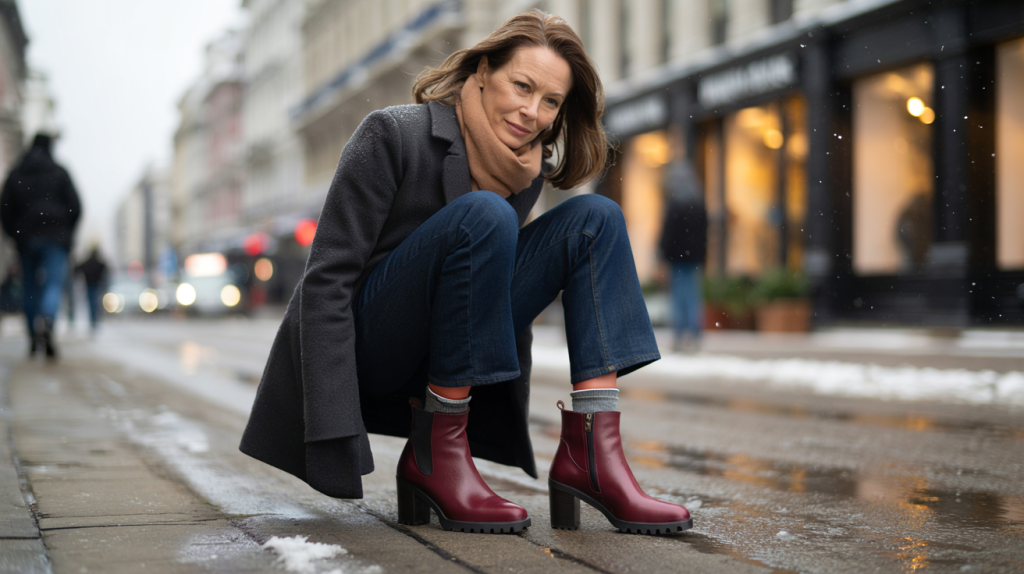Boots that shave years off a winter outfit do exist. The trick is choosing shapes and materials that sharpen lines, lengthen the leg, and still hug warmth when pavements bite with frost.
After 40, the goal shifts from trendy to modern – a clean, flattering boot that feels current, not teenagerish. Think slim ankle or mid-calf, a modest lift, grippy yet refined soles, and colors that brighten winter skin tones. That is the fast path to a younger silhouette without sacrificing comfort.
Why winter boots after 40 can look instantly younger
The eye reads length first. A slightly cropped hem with a sleek ankle boot leaves a slim gap – that tiny line breaks bulk and visually stretches the leg.
Toe shape matters. An almond or soft square toe looks contemporary and elegant, while very round toes can look chunky on thicker winter outfits.
Contrast lights up the face. Chocolate, taupe, burgundy, forest green, and winter white tend to freshen black-heavy wardrobes. One shade lighter than your coat turns boots into a style lift, not a heavy anchor.
Comfort first : the science of warmth, grip, and heel height
Insulation numbers help decode warmth. 3M explains that Thinsulate footwear insulation commonly comes in 200 g – good for city cold – and 400 g for deeper winter. Pick the lowest weight that keeps you warm on a normal day to avoid bulk.
Temperature ratings are a guide, not gospel, but they set expectations. Sorel lists several models rated to -32 °C for dry, inactive wear, a reminder that build and materials matter more than trend.
Moisture control keeps feet warm. The Woolmark Company notes merino can absorb up to 30 percent of its own weight in moisture while still feeling dry, which helps when switching between snow and overheated transport.
Grip is measurable. The EN ISO 20347:2022 occupational footwear standard uses SRA/SRB/SRC tests to rate slip resistance on ceramic and steel surfaces with wet or oily contaminants. Some winter fashion boots reference these test codes – that is a green flag for real traction.
For posture and comfort, a stable block heel around 3 to 5 cm tends to flatter calves and reduce the stomp effect. Podiatry associations like the American Podiatric Medical Association highlight supportive footbeds and roomy toe boxes with their Seal of Acceptance, useful when scanning spec sheets.
Styling moves that refresh the silhouette
Small switches change everything. Here is the evergreen playbook that readers save and reuse every winter.
- Cropped straight jeans or a gentle taper that kisses the boot shaft for a clean line.
- Opaque tights that match the boot for a leg-lengthening column under dresses.
- Coats ending mid-thigh with ankle boots, or knee-length coats with mid-calf boots to avoid visual cuts.
- Sock trick : thin merino liner plus a sleek boot – warmer and less bulk than thick socks.
- Hardware light-touch : one zipper or a tonal elastic beats multiple buckles that can age a look.
Smart shopping : models and materials that deliver
Start with shape. A slim Chelsea with a slightly higher shaft hugs the ankle and slides under straight jeans. A mid-calf boot that stops just below the widest part of the calf avoids cutting the leg visually and can accomodate thicker trousers.
Then check construction. Look for waterproof leather or sealed seams for slush days, a thermal lining labeled 200 g or 400 g when needed, and outsoles with defined lugs that are not oversized – all-day walkable without the combat vibe.
Details do the rejuvenating work. Side zips keep the upper clean, tonal stitching reads polished, and a gently sculpted sole looks lighter than a flat platform. An almond toe in rich suede or oiled leather softens lines near the hem of a skirt or knitted dress.
Materials decide longevity. Leather with a light oil finish resists salt marks better than untreated nubuck. If you run cold, a merino or shearling footbed adds warmth without forcing a thick sock. On truly icy routes, consider clip-on traction devices that meet SRC-level grip tests under EN ISO 20347:2022 for commuting, then remove at the office.
When labels list references, use them. 3M Thinsulate weights signal thermal intent, Woolmark merino tags point to moisture control, and APMA seals flag supportive designs. A modern, younger-looking boot ends up being the one that moves well through your day – presentable at 8 a.m., steady on slick sidewalks at 6 p.m., and still sleek under a dinner coat.
